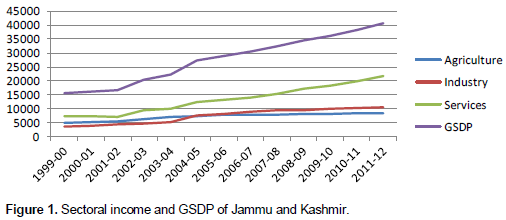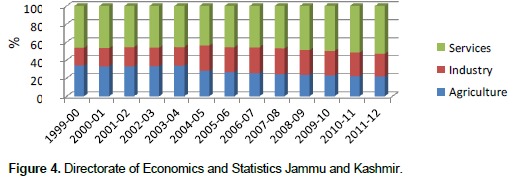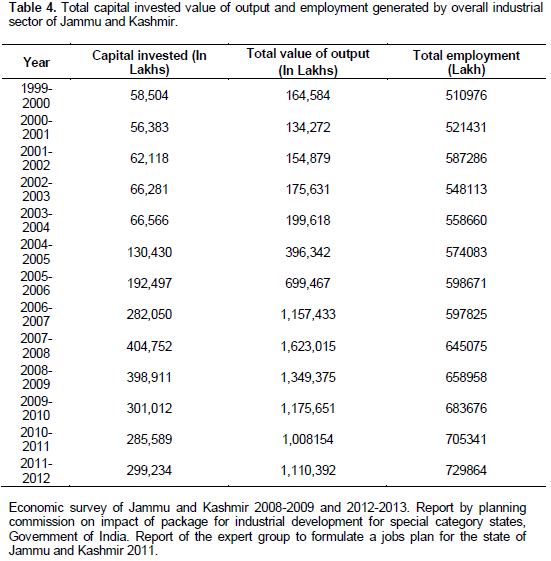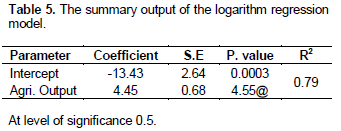The Jammu and Kashmir economy depends mostly on traditional forms of occupation. The state is affected by continued violence and insurgency, the economy of Jammu and Kashmir is an undeveloped one. Economy of Jammu and Kashmir is unaffected and unaltered by modern day industrial developments and changing times, the indigenous traditional occupations of farming, animal husbandry and horticulture forms the backbone of the economy. Agriculture is main sources of livelihood in the state were 70% of population eke out their living from agriculture and 49% of total working force directly depends on this sector for their livelihood, the slow growth in agriculture and allied sectors is a major cause of concern. Industrialization is considered as modern way of development for a region but J & K has not been able to attract investments in this sector and remained an industrially backward state due to its unique economic disadvantages arising out of remoteness and poor connectivity and most importantly the political uncertainty.
In this regard Agriculture industry linkage for such economy is important to be analyzed so as to generate a suitable growth with the collective efforts of these two sectors. Kuznets (1968); Kalecki (1976), Mellor (1976), Singer (1979), Adelman (1984), Ranis (1984), and Vogel (1994), highlighted the interdependence between agricultural and industrial development and the potential for agriculture to stimulate industrialization. They argue that agriculture’s productive and institutional links with the rest of the economy produce demand incentives (rural household consumer demand) and supply incentives (agricultural goods without rising prices) promoting modernization. Satyasai and Viswanathan (1999) find that, in pre and early independence period the industry sector had a close relationship with agriculture due to the agro-based industrial structure. Saikia (2010) observes that Agriculture-industry linkages have been deteriorating over the years and there have been directional changes linkages were primarily from the Industry to Agriculture sector. Viswanathan (1999) found that the output elasticity of industry with respect to agriculture was 0.13 during 1950 to 1951 to 1965 to 1966. Jha (2010) analyze that the process of growth of Agriculture and Industry in tandem, reinforcing and reinvigorating each other’s growth impulse, by resolving each other’s potential realization problem. Bhaduri (2007) extend Kaldor’s model by considering the role of agriculture surplus from the supply side as well as the importance of the demand side effects for industrial goods. Scitovski (1986) linkages concept has been recognized as playing a crucial role and providing substantial contributions towards guiding the appropriate strategies for future economic development. Vyas (2004) and Bathla (2003), the share of Agriculture in GDP, however, does not reflect adequately the role of Agriculture growth has played and will continue to play in Indian economy. Rangarajan (1982), Bhattacharya and Rao (1986), and Chowdhury and Chowdhury (1995), deteriorating linkages between agriculture and industry have been primarily credited to the deficiency in demand for agricultural products, decline in share of agro-based industries coupled with slow employment growth Sastry et al. (2003), for the period 1981 - 1982 to 1999 - 2000, found that the forward production linkage between agriculture and industry has declined, whereas backward production linkage has increased. They also found significant impact of agricultural output on industrial output, and that agriculture’s demand linkage to industry has declined, while that of from industry to agriculture has increased. Thus this paper will through light on the status of Agriculture and industry and also show the Agriculture industry linkages in terms of income and output in Jammu and Kashmir.
Objective of the study
(1) To study the status of Agriculture and industry sector in Jammu and Kashmir Economy.
(2) To analyze the Agriculture industry linkages in terms of Income and Output in Jammu and Kashmir economy.
The study has used time series data covering thirteen years period from 1999-2000 to 2011-2012. This study analyzes the growth of Agriculture and Industry sector in economy of Jammu and Kashmir by compound annual growth rate. In this paper three simple logarithm regression equations has be used to analyze the linkages between Agriculture and Industry sector in Jammu and Kashmir that is,
LogY Ind.Inc = β0 + β1LogX Agri.Inc+ µ (1)
Where Y Ind.Inc =Dependent variable (Industry income), β0 = Intercept, β1 = Regression coefficient of X variable, X Agri.Inc= Independent variable (Agriculture Income)
LogY Agri.Inc= β0 + β1LogX Ind.Inc+ µ (2)
Where Y Agri.Inc=Dependent variable (Agriculture Income), β0 = Intercept, β1 = Regression coefficient of X variable.
To find the agriculture –industry linkages in terms of output the following regression has been used:
Y Ind.Inc= Independent variable (Industry output)
Log Y Ind.Output = β0 + β1LogX Agri output+ µ (3)
Where Y Ind.Output =Dependent variable (Industrial output), β0 = Intercept, β1 = Regression coefficient of X variable, X= Independent variable (Agriculture output).
Income growth and agriculture industry linkages
Mostly, the economy of Jammu and Kashmir depends on the traditional occupation which includes horticulture, animal husbandry and the most common one agriculture. This forms the economy of the state of India. This state is affected by the continuous insurgency and violence, the economy of J & K is not developed or you can say it is underdeveloped. However, in past few years, government of J & K has taken few important steps to enhance the financial conditions of Jammu and Kashmir as well as to improve the standards of living of local people with the result the Jammu and Kashmir state has not only maintained the increasing growth trajectory since 2009 to 2010 but also is showing increasing trend, when the growth rate clocked to over 6%. The J & K state has not only maintained the increasing growth trajectory since 2009 to 2010 but accelerated it further to new heights especially during 2010 to 2011 and 2011 to 2012 when the growth rate clocked to over 6%. The economy of Jammu and Kashmir has shown vibrant growth path during the recent years. Gross state domestic product (GSDP AT constant price 2004 to 2005) has increased from Rs 15659.81crore in 1999-2000 to Rs40770.83crores in 2011 to 2012. The real GSDP grows around 6% average during 2011 to 2012, while as inflationary growth is 4.40 percentage points making an aggregate growth of 9.99% at current prices during the same period. In total GSDP agriculture contribute Rs8478.71crore in 2011 to 2012 which was Rs4902.80crore in 1999 to 2000. Similarly industry and services sector contributeRs10529.72crore and Rs 21762.40crore respectively in 2011 to 2012. As shown in Figure 1 the GSDP of Jammu and Kashmir and its sectoral share. Figures 1 and 2 sectoral income and GSDP of Jammu and Kashmir.


It is evident from the figure that the GSDP of the state is increasing year after year, though the rate of increase is low. The agricultural sector is increasing at decreasing rate and has remained constant in last few years. The services sector is the only sector which has shown the upward trend since the beginning of study period. The services sector is now the important component of GSDP growth in the state. As the industrial sector’s income is increasing with growing upwards at constant speed and has maintained a higher trend of growth but the fluctuations are more in industry sector that Agriculture and services sector due to different prevailing situations in the state.
The state economy is growing at an average of 6.22%, while as the agriculture and industry sector is growing at 3.69 and 2.1% respectively. The GSDP of the state is showing increasing trend in reference period of 13 years. The growth of the economy is growing at very low pace but is growing. As far as agriculture is concerned it is not increasing well. In 2001 to 2002 it was growing at5 5.92% but it reduces upto 3.69% in 2011 to 2012 while as the industrial. As shown in Figure 3.

The growth rate of the economy of Jammu and Kashmir Kashmir has shown irregularity and heavy fluctuation over the time. It is only services sector of the state that is positively increasing at increasing rate while as in industry and agriculture sector is more up and down. The instability in the growth of industry and agriculture sector can be seen in the growth of overall economy which shows that when there is positive growth in the Agriculture and industry sector of the state the economy in GSDP of the state grows accordingly and vice versa. As shown in Figure 4.

The sectoral contribution of different sectors of Jammu and Kashmir economy to GSDP is fluctuating over the years. When there is increase in income from agriculture, industry sector increases and similarly when there is growth in industry there is growth in agriculture sector and collectively increase GSDP. But from 2006 to 2007 it seems that there has been transformation, as with the decrease in income from agriculture the income from industry increases and when income from agriculture increases income of industrial sector decreases which results fluctuation in GSDP of the state.
As we deals with the Agriculture and industry sector we will obtain compound annual growth rate (CAGR) of these two sectors over the years. The compound growth rate of the income of these two sectors will give us accurate picture of performance of these two sectors in the study period with GSDP as well. Below is the compound growth rate of these two sectors with GSDP divided into three sub periods (Table 1).

The compound growth rate of agriculture in our first period of study period during 1999-2000 to 2004-2005 was 3.83 per annum which decreases to 1.82% in next period of seven years that is, from 2005-2006 to 2011-2012. In cumulative manner the agriculture in the period of thirteen years from 1999-2000 to 2011-2012 has attained annual compound growth rate of 2.77%. It shows slow growth rate through the study period. The com-pound growth rate of GSDP in Equation (1) period remain 4.04% annually in period from 1999-2000 to 2004-2005 and increases to 5.90% in Equation (2) period from 2005-2006 to 2011-2012. The compound growth rate of GSDP in the study period remains 4.69% that is most worried part of the economy.
It appears from the table that the industrial compound growth rate was high in first period and was higher than GSDP that is, 5.54% annually from period 1999-2000 to 2004-2005 and reduces in next period from 2005-2006 to 2011-2012 to 4.38. The compound growth rate of industry remains 4.92% annually in our study period. Thus in the study of thirteen years the industrial sector has higher growth rate than GSDP which shows that in this period the industrial sector has boosted in economy while agriculture sector is losing its strength and is not able to sustain its growth.
Agriculture industry linkage in terms of income
To find out the influence of income growth in agriculture sector by industry sector and influence of income growth in industry sector by agriculture sector for analyzing the agriculture- industry linkage in terms of income to see whether the income growth of agriculture in GDP affects income growth of industry in GDP and vice versa. We have worked with two logarithm simple regression model for these two problems to identify the effect of these two sectors on one other in terms of income growth by them in the economy of Jammu and Kashmir. To explore exact relationship between Agriculture and industry we use simple logarithm regression function. The equation will follow whether the agriculture income growth in the state influences the industrial income growth in the state. Here we have to analyze how far the progress in the Agriculture income influences the progress the industry sector income. Equation (1) for this problem will be.
LogY Ind.Inc = β0 + β1LogX Agri.Inc+ µ
Where Y Ind.Inc =Dependent variable (Industry income), β0 = Intercept, β1 = Regression coefficient of X variable, X Agri.Inc= Independent variable (Agriculture Income).
For Equation (1) we hypothesis that:
Hypothesis 1
H0: There is no linear relationship between industry in-come growth and agriculture income growth or agriculture income growth does not affect the Industry income growth
in the economy of Jammu and Kashmir.
H1: There is linear relationship between Agriculture income growth and Industry income growth Or Agriculture income growth affects the Industry income growth in the economy of J & K.
From Table 2 it can be seen that linkage between the agriculture and industry income has been highly sig-nificant during the period. The elasticity of industry GSDP income with respect to Agriculture GSDP income has been 1.98 which is significant. Equation (1) will be as:
? Ind.Inc = -3.81 + 1.98X Agri.Inc (4)

The equation shows that the industry income will increase with respect to agriculture income as if an average one unit increase in income of agricultural sector will lead to more than a unit increase in the industrial sectors that is, 1.98%. Thus agricultural sector income has great linkage with Industry sector in terms of income. The intercept value is about -3.81 which implies that if Agriculture income is held at zero level, the Industry income growth will be negative as -3.81%. Thus this make a sense that in the state of Jammu and Kashmir Agriculture sector laid influence to growth of income in industry sector. The R2 value of 0.91 means that 91% variation in Industry income is explained by Agriculture income growth.
Similarly to identify the influence of industry income on the progress of growth in agriculture sector income. Equation (2) for this problem is:
LogY Agri.Inc= β0 + β1LogX Ind.Inc+ µ
Where Y Agri.Inc=Dependent variable (agriculture income), β0 = Intercept, β1 = Regression coefficient of X variable, X Ind.Inc= Independent variable (Industry Income).
For Equation (2) we hypothesis that:
Hypothensis 2
H0: There is no linear relationship between agriculture income growth and industry income growth or industry income growth does not affect the agriculture income growth in the economy of Jammu and Kashmir.
H1: There is linear relationship between Industry income growth and agriculture income growth or industry income growth affects the agriculture income growth in the economy of J & K.
From Table 3, it can be seen that linkage between the industry and agriculture income has been less significant during the period. The elasticity of agriculture income with respect to industry income has been 0.46 which is less significant than Industry elasticity by agriculture sector. Equation (2) will be as:
YAgri.Inc= 2.07 + 0.46XInd.Inc (5)
The equation shows that the agriculture income will increase with respect to industry income as if an average one unit increase in industrial income will yield less than a unit increase in the agric sector that is, 0.46 thus agricultural sector has low level of linkages with agriculture sector in terms of income. Thus this make a sense that in the state of Jammu and Kashmir industry sector laid influence to growth of income in agriculture sector but magnitude is low. The R2 value of 0.91 means that 91% variation in agriculture income is explained by Industry income growth. Now to test the null hypothesis we analyze the p value of the variable or function. As noted from the table that p value is 2.26 which is greater than 0.5 level of significance. Thus the null hypothesis is not accepted and we conclude that there is relationship between Industry income and agriculture income.
Agriculture-industry linkage in terms of output
The industrial sectors of the state are mainly constituted of medium and small scale industries. Khadi and village industries are main components of industry of the state. In other words we can say that the industrial sector of the state is of traditional based and of small scale nature with low expansion of heavy and large scale industries. The growth of the industrial sector is low because of many problems which results low production and less employment generation. Small scale units are mostly agro-based and Khadi and village are of cottage type industries based which is directly or indirectly connected with agriculture of the state or raw material from outside the state. In analyzing the linkage/relationship of agriculture and industry for future prospects for development of Jammu and Kashmir economy we have try to identify the cause and effect relationship between the agriculture output and industrial output in which we try to understand the dependence of industrial output on the agricultural output of the state in terms of value of final output in rupees. For that we need data for value output of industrial production of the state and the agricultural output respectively. The total industrial output value and total employment generated by total industrial sector of Jammu and Kashmir is shown in Table 4.

Now to understand agriculture-industry linkages in the economy of Jammu and Kashmir we will identify a simple logarithm regression model by which we identify the influence of agricultural output on growth performance of industrial output generated in Jammu and Kashmir which are mainly of agriculture based. This is worked by regressing agricultural and industrial production in terms of Rupees and in log values of those output values for thirteen years from 1999-2000 to 2011-2012. For that we have used simple logarithm regression function because the values are big in number. The equation of this model is:
Log Y Ind.Output = β0 + β1LogX Agri output+ µ
Where Y Ind.Output =Dependent variable (Industrial output), β0 = Intercept, β1 = Regression coefficient of X variable, X= Independent variable (Agriculture output).
Table 5 shows the result of the model which shows the influence of agriculture output on industrial output. The regression results are as follows:
? Ind.output = -13.43 + 4.45X Agri output

The above results show that the elasticity of industrial output with respect to agricultural output is about 4.45 which suggesting that if total Agricultural output increases 1 percent on an average, the Industrial output will increase about 4.45%. The industrial output of the state is very responsive to change in agricultural output. Thus it seems that there is positive relationship between agriculture output and industrial output in the state of Jammu and Kashmir were the main pattern of industries is agro-based. If we look upon the intercept value which is -13.43 which reflects that if agriculture output will be zero the Industrial output will be -13.43% which means negative growth in industrial output. The R2 value is of about 0.79 implies that 79% of variation in industrial output is explained by agricultural output. Now to test null hypothesis of the function we analyze p value. As observed from the table that p value of the function is 4.55 which is greater than 0.5 level of significance. Thus calculated value is greater than tabulated value thus our null hypothesis is not accepted and thus we conclude that there is close and significant relationship between agricultural output and industrial output of Jammu and Kashmir State. Thus it is evident from the model that in Jammu and Kashmir the basic pattern of industrial sector is agro-based were the industries are mainly of small units.
The Jammu and Kashmir economy is going through the phase of transformation from agriculture to services sector, but this transformation will not be sustainable because industrial sector does not support the services sector and agricultural sector which is mostly important for smooth growth process of an economy which results that in last few years the economy of the state is losing share in Indian economy and declining growth of state economy. The change in the economy is strengthened because of higher trend of growth rate shown by the industry sector while as from agriculture sector it is low during the period of thirteen years. The regression models used to analyze the agricultural–industry linkages in terms of income has shown very much important facts it was found that the agriculture sector income of the state helps in development of the industry sector very much. In other equation it reflects that the Industry sector of the state has not been able to support the agricultural income growth in large manner. We found that Agriculture of the state is highly influencing the output of the state. The elasticity of Industrial output with respect to agricultural output has 4.45 which means that with 1% increase in agricultural output industrial output increases 4.45% this shows the dependency of Industry sector of the state on agriculture sector. Thus the pattern of industry sector of the state is of micro, small and medium type units or cottage type industry sector with full support from agriculture sector.
Thus in nutshell the agriculture-industry linkages in the economy of Jammu and Kashmir are weak while agriculture sector provide its support to industry sector but industry sector is not yet able to support agriculture sector results slow growth of agriculture sector and in reverse slow growth in industry sector as well which collectively reinforce the slow growth of economy of Jammu and Kashmir.
(i) The industrial infrastructure of the state is worst than other states of India so it should try to strengthen the infrastructure so that the linkage between agriculture and industry will improve.
(ii) The most important step which state should take to improve Agriculture-Industry linkages is to formulate essential policy for development of industry sector of the state.
(iii) The state should try to encourage the investors from outside the state as well as local investors to invest in the small and medium sized industry units of the state by offering incentive or other benefits.
(iv)The state should try to setup the industry units in rural areas to displace the people from agriculture to industry sector for employment purpose.